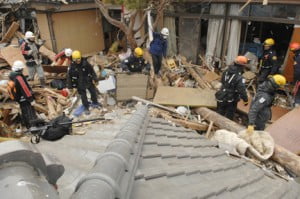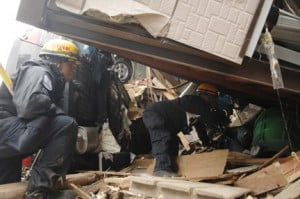
By Mary O’KEEFE
Members of the California Task Force 2, Urban Search and Rescue team for Los Angeles County Fire Department is back in the states after their deployment to Japan.
The team left in response for assistance after an 8.9 magnitude earthquake and subsequent tsunami on March 11.
The team of 74 members left March Air Reserve Base on March 11 fully loaded with heavy equipment and boats.
“We did bring boats and our swift water equipment but they were not used,” said firefighter and paramedic Brian Clayton.
The team landed in Japan and had to travel several hours to get to their destination of the port city of Ofunato.
“There were many small towns up and down the coastline that have different levels of shipping,” Clayton said. “[At this town] we were at had an inlet. Apparently the tsunami gained momentum as it narrowed down.”
Ofunato had a population of 42,000. The team’s main goal was search and rescue, however the devastation was great and they were not able to find any live victims.
The mission shifted from search to recovery.
“That’s not what we want to do,” Clayton said.
Capt. Doug La Count was also a member deployed to Japan. He said that the team’s goal is always rescue but they changed gears and had hoped that if they could recover victims they might give peace to some families who were looking for loved ones.
For two days they searched Ofunato then moved to a port town, Kamaishi. They devastation was more concentrated there.
“There were a lot more houses in Kamaishi,” La Count said.
There were teams from all over the world that responded to the disaster. The overall devastation was incredible but each team given a specific area, which helped them concentrate on one section.
La Count had been on the team that responded to the Haiti earthquake last year. The destruction was incredible there as well but the tsunami was different.
“The tsunami is a completely different animal,” La Count said. “The debris you saw on TV and the Internet that is what we saw. There wasn’t nearly the standing water we thought there would be.”
As the water receded it left it’s muddy devastation.
“There would be large fish on the street. You would be walking down [a road] and see an eel,” Clayton said.
“Or an octopus. Large fish,” La Count added. “You can train all you want but the tsunami was different. That water is very unforgiving.”
Both Clayton and La Count said they were impressed with the response of the Japanese government to the earthquake and tsunami.
“We were told the residents had about 15 minutes of warning for the tsunami. That’s not a lot but it did give them some time to get to higher ground,” La Count said.
The people were obviously devastated but did not show their grieve openly, Clayton said.
“The people were gracious,” Clayton said. “And we didn’t any looting.”
The L.A. County Fire Department team is only one of two teams in the United States that have been approved for International search and rescue response. The other, Team 1, is in Virginia.
“The team is certified for FEMA (Federal Emergency Management Agency) operations in America for emergencies like hurricanes, floods and earthquakes. Natural and manmade disasters,” Clayton said.
A few years ago the team was certified as an International Urban Search and Rescue and can now be called out to anywhere in the world.
They train with the military at March Air Force Reserve Base. Because of the heavy equipment they travel with they often use military transportation. They train with the base personnel to be ready to deploy as quickly as possible.
The equipment they bring is used for many rescues methods including breeching. Clayton explained that breeching is when they have to cut through layers to get to a victim. For example if a building collapses due to an earthquake. The fourth floor is on top the third, which is on top of the second and so on but there is a void between the floors.
“Sometimes the only way you can get to those [lower floors] is from the top down,” Clayton said.
The team uses jackhammers and concrete saws to cut through the floors. They may sometimes use ropes and repel into the area to rescue.
“In New Zealand the team was working on [a collapsed] an elevator shaft,” Clayton said.
The team initially trains for over 100 hours and continue to train throughout their time on the team. This is not something that they receive extra pay for or any promotions. This is a calling and all are ready to be deployed to where ever they are needed.

